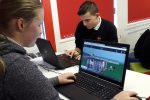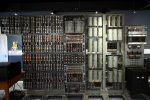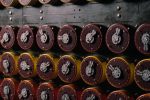
A gifted student has created a brand-new version of the Turing Test that has entertained and intrigued educational groups on the Learning Programme at The National Museum of Computing for many years. The Turing Test aims to challenge its users if they can tell if they are talking to a machine or a human.
As part of his A-level coursework in computer science, Niccolo Mattarei, of West Bridgford School in Nottingham, has created a Turing Test that enables students to play against each other. His program links some computers to students, and some to machines that provide automatic answers. Initially, the students cannot tell what link they are using. Can they tell a fellow student from a machine?
Niccolo Mattarei explained, “I had read about the Turing Test as an abstract concept but had never considered how it might be implemented until the opportunity with TNMOC arose. It needed coding beyond that required for A-Levels, so it was immensely satisfying to set it up and see it working on the TNMOC’s classroom computers. I have written it in a way that it can be modified and improved, so with luck, it will be usable for years to come.”

Toby Eyre, head of enterprise at the West Bridgford School, said, “To prepare our students for degree courses and employment, we encourage our A-level computer science students to be ambitious and to tackle real-world problems with external clients for their coursework projects. The sophistication of Niccolo’s project is far above the requirements of computer science A-level, so it’s little wonder that he was awarded the top grade in this year’s results. It is very rewarding to teach and support students of such calibre.”
Anne-Marie Sandos, head of learning at TNMOC, said, “Niccolo’s version of the Turing Test is exceptionally smart. It challenges students to think about the nature of their interactions and to compare human intelligence with artificial intelligence. They can then learn to develop their own chatbots, which are now commonly encountered in everyday life, often online or by telephone. Anyone with the ability to develop a chatbot is in great demand by employers.
“Our visiting students leave the museum with rich insights of the development of AI – having experienced AI applications and having seen in action the best-known work of the leading pioneer of AI: the Turing-Welchman Bombe that broke Second World War enemy ciphers.”
The highly popular Learning Programme at The National Museum of Computing provides educational groups from the age of 10 with unrivalled insights into the development of computing. See tnmoc.org/learning for details.



















